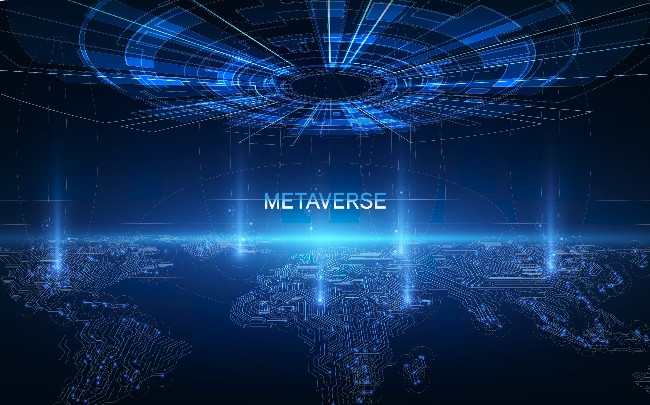New technologies emerge frequently. But most of the innovations fall by the wayside, and only a few go mainstream. In such a context, is Metaverse the next version of the Internet, or is it hype?
The Metaverse is a virtual twin of the real world. It offers a virtual and immersive parallel reality that allows people to meet and interact digitally, in real-time.
Metaverse unlocks a host of digital opportunities not available until now. People may, for instance,
- Hold a meeting with colleagues.
- Go on a sightseeing trip with family.
- Hit the mountains for a trek with friends
- Organise business meetings,
- Wander around a shop
…and do much more, from the comfort of their home, in a real-life simulated environment. The technology combines 3D and immersive experiences not available in the current 2D Internet.
Metaverse also unlocks a host of commercial opportunities, especially in art, commerce, health, media, and social collaboration. Some of the leading commercial use cases include:
- People explore homes and make buying decisions without having to make a site visit.
- Hyper-personalised shopping. Shoppers may try out clothes from the convenience of their homes before making a buy decision. Businesses may also provide unique loyalty experiences for their customers.
- Participative commerce. Customers may co-create experiences and exchange goods through innovative ways of community engagement.
- Holding concerts and sporting events. Participants get a real-life feel of attending a sporting event or a concert while sitting on their home couch.
- Simulated training experiences. Businesses may create virtual customer interaction points and shop floors to train their employees.
- Enriching games. Several games, such as Second Life, Roblox, Minecraft or Fortnite, already enable Metaverse. The players create avatars and equip them with accessories. Some games even have their digital currency.
Metaverse takes social media to the next level by offering real-dimensional digital avatars of people. The Metaversum enables endless, interconnected virtual communities. Recently, the Yug Metaverse organised the first-ever Holi set in Metaverse, with great success.
Bloomberg Intelligence estimates the Metaverse business to touch 800 billion US dollars by 2024. The virtual world will soon become more extensive than the physical one in economics, if not in scale.
But for all the potential, several challenges stand in the way of Metaverse becoming the future of computing.
Industry adoption of Metaverse
Many top brands have joined the Metaverse bandwagon or are investing in Metaverse. Some leading adopters include Adidas, Disney, Mcdonalds, Nike, Samsung, and Walmart.
The UK sports club Manchester City is investing $100 million to create its Metaverse. The project, executed by Sony, will be completed by 2024. Atlanta Braves baseball league club, and Emirates Airlines have announced similar big-ticket plans.
Travis Scott’s live Fortnite concert in the Metaverse in April 2020 attracted 27.7 million unique attendees. The figure is far more than what a typical physical concert venue accommodates.
To promote user adoption, many companies such as McDonald’s, Burberry, and others, have launched non-fungible tokens (NFTs). Louis Vuitton’s “Louis the Game” integrates 30 NFTs into a mobile game. The US National Football League offered Super Bowl spectators a free NFT specific to their seats. Many prominent film stars in India, such as Amitabh Bachchan and others, have also launched their NFTs.
But entering Metaverse is a costly proposition. A business investing in Metaverse depends on:
- The risk tolerance of the enterprise, or the extent to which they bet on the future value.
- The willingness of the enterprise to co-opt Metaverse into the business strategy. Many companies do not enter Metaverse as a strategic choice, considering the potential disruption it brings.
- The capacity, including financial strength, to make long-term investments.
The challenge of technology adoption
Metaverse positions itself as the “network of the future.” It combines today’s Internet with real-world elements to innovate a virtual world. But success depends on users being able to adopt the technology. And the technology necessary for Metaverse to flourish is in its infancy.
The basic user hardware includes sensors, virtual reality glasses, and augmented reality headsets. Such hardware has to become as ubiquitous as a PC mouse or a smartphone. Increased user adoption depends on price reduction. VR headsets, such as the Oculus Quest developed by Meta, now have a price tag of about $300.
Increased user uptake also depends on the transformation of the 2D Internet into a three-dimensional domain. Presently, users only see and hear through the Internet. For the Metaverse to become mainstream, the everyday user should also be able to feel through the Internet. Otherwise, Metaverse will be a repacking of existing 3D technology in a new, fancy bottle.
Seamless Metaverse depends on real-time detection and correction of errors in the simulation. Doing so requires mature artificial intelligence tools.
Also, users will need tremendous bandwidth and computing power to make the virtual world appear real. Even the slightest delay in transmission degrades the experience.

Web3
Web3 is the open version of the Internet that gives users greater control over their content. Web3 co-opts the cloud, edge computing, 5G wireless, augmented reality, and virtual reality. Also, blockchain ledgers, crypto-currency, and NFTs come naturally in web3. In today’s Internet, these technologies are an add-on layer and, as such, not always configurable easily.
The adoption of Metaverse by businesses depends on the evolution of Web3. Users have to ingrain web3 platforms in daily interactions. Web3 requires a computational efficiency improvement of 1,000+ times above today’s level, meaning such a state is still some time away.
Challenges of finding talent
User adoption of Metaverse ultimately depends on the ability of developers to create virtual worlds that feel real. Enterprises often delay adoption because of talent scarcity to develop Metaverse applications. Metaverse will not escape the skill shortage plaguing the tech space.
The stakeholders of Metaverse pin their hopes on small developers enriching the world of Meta. The parallel of start-ups developing apps and enriching the smartphone ecosystem in the late 2000s offers hope.
Several DIY tools are also on the anvil. Nvidia’s open-source tool, Omniverse, allows users to build virtual worlds using artificial intelligence and 3D modelling. Platforms such as Unreal Engine or Unity make it possible to draw up 3D models for Metaverse. But most of these current Metaverse platforms are desktop-first and not mobile-first, limiting reach.
Shortcomings of Metaverse rules
Metaverse policies and rules need refinement.
Consider a painstaking effort to create a beautiful historic palace or any other 3D Model in Metaverse. When the developers transport these models into the current global Web3 Metaverse, users can decimate the work just as quickly.
The commerce potential of the Metaverse depends on a functioning economy with currency. NFTs (Non-Fungible Tokens), assigned to an owner and not exchangeable or copied, fill the void. But NFTs have their limitations. Many experiences in the Metaverse require cryptocurrencies specific to Metaverse platforms.
Metaverse is the first attempt at creating a virtual world. Similar initiatives have been stillborn several times. Earlier, IBM had hosted its conference centres in the virtual world. Several apparel shops in the US, and others, have all toyed with creating immersive virtual spaces. The 2000s game “Second Life” especially attracted the masses with the possibilities of a virtual reality world. The game is still online but with grotesque graphics. Metaverse goes much beyond virtual reality, though. The Metaverse combines the physical and digital world in a persistent and immersive manner. Also, advances in technology will soon overcome the technical challenges that impede user adoption.
A report from Citi, “Metaverse and Money.” estimates Metaverse as a $13 trillion market opportunity, with the user base touching five billion soon. Despite all the challenges, the Metaverse is on its way to becoming the next generation of the Internet.
If you need more information or free assets on metaverse, please feel free to contact us. We will be happy to share further information on this.












